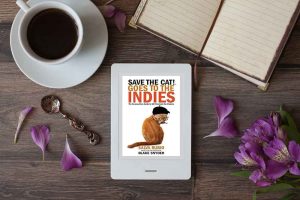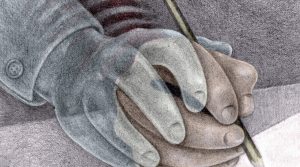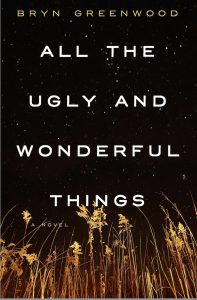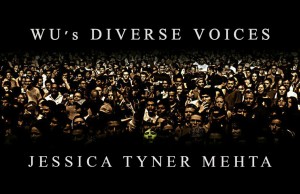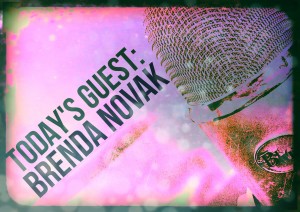Interviews
Back in the early days at Writer Unboxed, Kathleen Bolton–my friend and co-founder here at WU–and I used to do weekly interviews with authors and industry gurus. These interviews not only brought us some fantastic traffic and were instrumental in raising WU’s profile, they were richly rewarding to everyone, including Kath and me. There were, of course, favorites. I think I can safely say one of Kath’s favorites was her interview with Diana Gabaldon (of Outlander fame). One of mine was with the brilliant and oh-so-charming Blake Snyder, author of a series of books for (screen)writers beginning with Save the Cat. Blake had just released his second book, Save the Cat Goes to the Movies, when we had our phone interview.
I’m going to share the first question from that interview with you here, because it’ll help to establish a grounding for the Save the Cat series and this interview as well.
TW: In the first Save the Cat, you introduce the idea that every story falls into one of ten new genre categories–Monster in the House, Golden Fleece, Out of the Bottle, Dude with a Problem, Rites of Passage, Buddy Love, Whydunit, Fool Triumphant, Institutionalized or Superhero. How does your latest book, Save the Cat Goes to the Movies, expand on this concept?
BS: In the first Save the Cat, I proposed that most well-structured stories fall into certain patterns. I pointed out fifteen points on the Blake Snyder beat sheet that I think are unique.
What I’m trying to get across is that there’s a function for every section of a story. As a writer myself, I’ve spent a lot of time trying to figure it all out. I’ve been lucky in that I’ve had a lot of success in selling scripts, and so breaking down the components of what makes any story work has always been my goal. That was the important thing in the first book.
The other important thing in the first book was the concept that there are ten story types. So what I wanted to do in the second book is basically prove my point, prove the case. In writing the second book, I wrote ten different chapters, each one about a different story type. I found five different examples of each story type and broke them out into the beats. It really is just proving the case.
“Just proving the case” makes it sound so simple, doesn’t it? But what Blake had done, I felt, was nothing short of astonishing, as he revealed the veritable DNA of story after story and type after type.
A brief aside: My son just finished his first year at USC’s School of Cinematic Arts. He wants to eventually direct films, though he could end up writing or editing, too. Point is, he loves story. We all love story. We put a movie on at my house, and after it’s finished we talk about that story for an hour, at least. What worked. What didn’t. Why. What we think could have made it better. My son’s had his hands on my well-worn copy of Save the Cat, and knew I’d had the honor of talking with and interviewing Blake. And so it was with some awe that he […]
Read MoreIt’s the scenario every writer dreams of: #1 New York Times Bestsellers. Movie deals. Book deals for 10 novels, one after the next.
Who could ask for more? Yet in the crazy world of publishing, even this stellar trajectory does not necessarily translate into the professional or financial stability most people need.
That’s why Nicola Kraus, whose novels, co-authored with Emma McLaughlin, include blockbusters such as The Nanny Diaries, So Close, The Real Real and Nanny Returns, turned a page in her own career a few years back to add professional ghostwriting and editing into the mix. Ever fascinated by how writers leverage their unique creative skills into satisfying, sustainable careers, I caught up with Nicola recently to hear about her path. Her work has been a great source of inspiration to me, so I’m all the more honored to speak with her here today. Let’s dive in.
Q: You’ve written and co-authored 10 wildly successful novels, including the New York Times bestseller The Nanny Diaries — which was made into a movie starring none other than Scarlett Johansson. How did you make the jump from crafting fiction to editing and ghostwriting nonfiction?
NK: Well, it wasn’t so much a jump as an evolution with so many factors :) When my co-author Emma McLaughlin and I started publishing fiction in 2002 it was easier to sell enough primary and foreign rights that two people could split the revenue from one book and live in New York City. But after 2008 foreign sales became increasingly rare. Magazines stopped serializing fiction, and six-figure film sales were phased out in favor of four-figure film options.
If we had been one person living outside the city we would have been in great shape, but after we had children we were forced to make some tough decisions about what we wanted to be getting out of our time away from them. At that point our responses diverged. She decided to go back to corporate life and I decided to immerse myself in what I loved about writing in the first place: not just the craft, but the art and magic of it. I did that by starting to teach, or ‘coach,’ aspiring authors, giving myself the financial freedom to go back to making art for the creative pleasure of it.
Q: There are all sorts of misconceptions about what “ghostwriting” really means, and there seems to be a stereotypical notion that it involves sitting down and writing somebody else’s book from scratch. But I’ve seen all sorts of permutations, from helping authors get their first drafts into final shape to polishing already-solid manuscripts. Tell us how you work.
NK: Lol! No, I don’t put words in anyone’s mouths! I have manifold ways of working with clients. And they all stem from one fact: as publishers merged and were bought out in the oughts, houses started employing fewer and fewer editors, but published more and more titles. Meaning authors now need people like me to help them do what they could once have found within an in-house author/editor relationship. […]
Read MoreI first met Bryn Greenwood in an online writing group a few years ago, and I was immediately struck by how clear and authentic her voice was. She doesn’t equivocate in her conversations or her writing. Her pull-no-punches style may sometimes be uncomfortable, but it’s always interesting.
Bryn, who bills herself as a “fourth-generation Kansan and the daughter of a mostly reformed drug dealer,” has an MA in creative writing and two small press novels, but it is her latest work, All the Ugly and Wonderful Things (St. Martin’s Press) that’s garnering talk. The Associated Press says that “This book won’t pull at heartstrings but instead yank out the entire organ and shake it about before lodging it back in an unfamiliar position.” Library Journal calls it “…so freakishly good and dangerous that it should come with a warning label.”
Intrigued? Then read on to get Bryn’s take on the road to publishing, what makes a character compelling, and whether it’s true that any publicity is good publicity. (And as a bonus, meet her big brown dogs!)
LM: True confession time — I have a big brown dog I call the Slobbering Beast, and my main goal in interviewing you was to get you to talk more about your own beasts. You have two, correct? Are they as much trouble as mine?
BG: I have two boxers, who are the most wonderful, pain-in-the-ass thing that ever happened to me. They were the dog equivalent of an unplanned pregnancy. I dated this guy and in the process of our very messy relationship, he left his dogs at my house. That was six years ago and now they’re my dogs. The one is a pretty pretty princess who lives to be petted and admired. The other is truly a slobbering beast, who hates all but about three people in the world. Her head is approximately the size of a car battery and she becomes unhinged when she has to confront anything with wheels on it. They really are the nicest thing in my life on any given day.
LM: Always nice to have the dogs to lean on during the publishing process, isn’t it? Speaking of which, your path to publication has been a twisted one. You’ve had fiction and essays appear in places like The New York Times and the Kansas Quarterly, you have an MA, and you have two previous novels published with indie publishers. On the surface, it sounds idyllic. Yet getting to this place where you are now — with a well-received book coming out from a mainstream publisher — has been a struggle. Would you talk a bit about that, and what kept you going?
BG: My experience is a reminder that the path to publishing is not linear. In 2008 I had an agent and a novel that went to several acquisition boards, but was never sold. It was enormously discouraging, but publishing is a Sisyphean chore. I had pushed my boulder to the top of the hill and fallen back to the bottom. After my agent and I parted ways, I […]
Read More
“What can I do to get my book onto a bestseller list?”
If I had a dime for each time an author has asked me this question, I wouldn’t need to be a bestseller myself to be rich. Until recently though, my answer has always been a disappointing, “I have no idea.” Or, “There’s nothing anyone can do.”
Then I had a fascinating conversation with the team over at Greenleaf Book Group, an independent publisher and book distributor. Greenleaf not only helps develop ideas into books which they then publish, promote and distribute they also also work with qualifying authors to make that bestseller list dream come true. And they’re successful at it.
What I learned was so eye-opening that I’ve invited Greenleaf marketing associate Magdalene Thomas to talk with me about strategies for reaching those bestseller lists in a Q&A here on Writer Unboxed. Magdalene’s work planning and executing strategic marketing campaigns with independent authors has resulted in numerous bestseller placements.
Welcome, Magdalene. Let’s dive in!
SB: When I heard that there are actually steps authors can take to help their books hit bestseller lists, I had to hit the universal reset button. Is it true?
MT: Yes, there really are steps that certain authors with the serious goal of becoming bestsellers can take. They primarily involve controlling volume and velocity of sales.
SB: That sounds so easy. What’s the rub?
MT: Every time I develop a marketing campaign for one of the many authors I work with, I ask: “What are your goals for this book?” Nine times out of ten, their response is some iteration of “I want to have a best seller.”
As someone who is acutely aware of the realities of placing on a best-seller list, I have to take a deep breath before I respond. Hitting a bestseller list is the ultimate validation of an author’s time, emotion, energy and ideas. Yet planning for this takes resources and the outcome is not guaranteed. So even though I can help my authors take the necessary steps, I also have to help them set expectations and encourage them to set more realistic goals.
There is a time and place for marketing campaigns focusing on high-level bestseller lists such as The New York Times. That type of campaign is not right for every book and author. Luckily there are also other types of bestseller campaigns that are more accessible, like on Amazon. It’s important for authors to assess which if any of these are best given their specific situations.
SB: What situations lend themselves to working toward placement on national bestseller lists like the New York Times or Wall Street Journal?
MT: A push for placement on a third-party best-seller list like The New York Times works best if you have an existing audience that is primed to purchase your book as it hits shelves.
These best-seller lists are determined by sales numbers within a
Read MoreIf you missed Part 1 of my interview with BookBub’s Industry Marketing Manager–or if you have no idea what BookBub is–click HERE, then come back. Today I’ll wrap my two-part interview with BookBub’s Diana Urban.
But first… Something unexpected and fortuitous happened on the way to seeing this interview published. My publisher, Crown, decided to run a BookBub on my second novel, The Moon Sisters, and initiated a temporary price drop. That BookBub goes live today, so I orchestrated things here at WU so this post could go live today, too.
‘Show don’t tell,’ right?
Below is a screen capture of stats for The Moon Sisters on Amazon, taken on 9/17, the day before the BookBub. Just so you have all of the facts, my Amazon rank before the e-book was put on sale on 9/13 was 240,000. It dropped to about 6,000 after the sale began and I ran a BookSends promotion. I’ve also promoted over social media, but nothing too extravagant or repetitive.
This is where things stood on Barnes and Noble as of 9/17:
This is the second time Random House has run a BookBub for The Moon Sisters. The first time was very succesful–the eBook reached #10 in Nook books at Barnes and Noble, and #1 in the Mothers and Children fiction category on Amazon and #116 overall. If you’d like to follow along today, you’ll see for yourself what happens to a book’s numbers on the day of a BookBub; you can watch The Moon Sisters’ pages at Amazon and Barnes and Noble. BookBub’s daily email usually lands around 10-10:30 EST, and the effect is not immediate but, well, you’ll know it when you see it.
Numbers update (9/19), for interested followers:
Within 24 hours of the BookBub for The Moon Sisters, the book reached #61 in Kindle books on Amazon (an increase of over 22,000%). It was again #1 in the Mother’s and Children fiction category, #3 in Psychological Thrillers, #3 in Coming of Age fiction, and #5 in Family Life fiction. It reached #13 at Barnes & Noble in Nook books, #13 in Kobo, and #49 in iBooks.
Without further ado, the second part of my interview with Diana Urban. Enjoy!
The Writer Unboxed / BookBub Interview, Pt 2
TW – Q16: In terms of author sales following a BookBub, is there a point where a given book, series, or author starts to experience diminishing returns with BookBub promos, and if so how can that be avoided?
BB: Each genre has anywhere from hundreds of thousands to millions of subscribers. Books sent to these massive and highly engaged lists typically experience a significant spike in downloads and revenue within the span of a few days. This often leads to increased retailer rankings, better performance in recommendation algorithms, and even hits on major bestseller lists like The New York Times or USA Today. This increased visibility usually gives rise to even more downloads from readers who find the title through these other outlets. These extra sales beyond those generated by BookBub subscribers are what we call the “halo effect.”
Independent author Cheryl Kaye Tardiff is a great example of this. Here is a graph showing book sales of her thriller […]
Read MoreWhether you know what BookBub is or you don’t, whether you have a book for sale now or are still working on a draft, whether you’re independently or traditionally published, you’re going to want to read this Q&A. First, for anyone who doesn’t know what BookBub is about, BookBub is a company that promotes quality e-books with temporarily–and drastically–slashed prices, via a daily newsletter and web updates. They are good at what they do. Very, very good. In a world where we as authors can’t be sure what will or what will not sell books, this seems one sure thing: A BookBub promotion means sales and lots of them.
How to use BookBub is something that stymies many authors I know, though, so when I noticed BookBub’s star presence at this year’s Book Expo America, I approached. That’s when I met Diana Urban, BookBub’s Industry Marketing Manager. I told her my publisher, Random House, had run a BookBub for my second novel, The Moon Sisters, which went exceptionally well. (As I revealed in an essay for BookCountry, sales for the eBook of The Moon Sisters had never really taken off. But the day after my BookBub, the eBook of The Moon Sisters was ranked #10 in Nook books at Barnes and Noble, and #1 in the Mothers and Children fiction category on Amazon.) We chatted for a bit, and then I asked if she’d be interested in doing an interview with me for Writer Unboxed. Happily, she agreed.
[pullquote]Bio Box: Who is Diana Urban? Diana is the Industry Marketing Manager at BookBub, where she regularly publishes content on book marketing, self-publishing tips, and publishing insights at the BookBub Partners Blog. She was previously the Head of Conversion Marketing at HubSpot and is an expert in inbound marketing, content marketing, and lead generation. Diana is also the author of two Young Adult thrillers, and is writing her third novel. Follow her on Twitter at @DianaUrban.[/pullquote]
I recently asked the Writer Unboxed community–mostly through our Facebook group–to chime in with any questions they had about BookBub, and many of those questions are reflected here. So let’s get to it–part 1 of a two-part interview.
The Writer Unboxed / BookBub Interview, Pt 1
TW – Q1: It’s the prevailing opinion that BookBub is unique among a pool of book-promotion services, in that it seems to move the needle in a much more significant way and have a lasting sales impact on the books that are promoted. Why do you think that’s the case?
BB: One of our core goals has always been to provide authors and publishers with a way to run book marketing campaigns that drive real, measurable results. We’re a data-driven company, so every decision we make — from the categories we launch to the new members we acquire — is based on the results of rigorous testing and analysis, which helps us ensure that BookBub continues to be effective at moving the needle for our partners.
BookBub is also unique in that we’re providing curated recommendations to millions of loyal power readers who have specifically opted into genres they’re interested in reading. Our partners […]
Read Morephoto “Unity in Diversity” by Flickr’s fady habib
We’re so pleased to introduce today’s guest and topic in our Diversity in Fiction series. Jessica Tyner Mehta is not only a critically acclaimed author, she’s the founder of a scholarship meant to promote diversity in fiction, specifically Native American fiction. Born and raised in Oregon, Jessica is the author of The Last Exotic Petting Zoo (shortlisted for a Pulitzer Prize) and What Makes an Always published by Tayen Lane Publishing, as well as 100 Ways to Make $100K with Your English Degree from Moonshine Cover Publishing. She is the founder of MehtaFor, a writing company which serves a variety of clients including Fortune 500 enterprises and major media outlets. Her company received the national bronze award for Startup of the Year from the American Business Awards in 2015.
Jessica received a Writers in the Schools residency from the Oregon Literary Arts Council for 2015-16. As a member of the Cherokee Nation, Jessica offers complimentary writing and editing services through her company to Native American students and non-profits based in the Pacific Northwest and/or serving Native communities.
She received her master’s degree in writing from Portland State University, and established The Jessica Tyner Scholarship Fund in 2013. An extensive traveler, she has lived in England, South Korea and Costa Rica. She’s a certified yoga instructor, avid runner, and collector of first edition books.
A Q&A with Jessica Tyner Mehta
I was the first person in my family to attend college—I knew nothing about the process, including that scholarships even existed. By the time I figured it out, it was the junior year of my undergraduate program and I had missed out on a lot of opportunities for those elusive “full rides.” During the last two years of undergrad, I was awarded 19 scholarships that were either Native American- or diversity-based.
In graduate school, I discovered the pickings were even slimmer (especially for someone getting a master’s degree in writing!). While I did receive a handful of fellowships and scholarships, the funding for a diversity-based and/or writing-based fellowship for graduate students was sparse.
I established this scholarship because I know first-hand just how challenging college and grad school can be, especially for Native American, first-generation and/or students pursuing a writing degree.
Jessica Tyner Scholarship
Award for students enrolling at least part-time in college graduate-level study at any four-year public or nonprofit college or university for fall term/semester and majoring in English, writing composition, or other related majors. Minimum 3.5 GPA preferred. Must write essay describing involvement with a Native American community. Semifinalists will be contacted and invited to submit writing samples (up to five pages) of any genre.
– Must be a graduate student
– Must attend a university
– Must be a US Citizen
– Minimum 3.5 GPA
– Must not be attending high school currently
– Restricted to students studying Literature/English/Writing
The Jessica Tyner Scholarship Fund is administered through the Oregon Student Assistance […]
Read MoreToday we are excited to have a Q&A with New York Times and USA Today bestselling author Brenda Novak, author of more than fifty books, including This Heart of Mine. A four-time Rita nominee, she has won many awards, including the National Reader’s Choice, the Bookseller’s Best, the Book Buyer’s Best, the Daphne, and the Holt Medallion.
Brenda also runs various fundraisers for diabetes research. To date, she’s raised $2.4 million.
Since my son was diagnosed with diabetes at the age of five, I’ve been compelled to do something to help him and all people who are fighting a similar battle. Every year, I orchestrate a big fundraiser. This year, I’ve curated three box sets, Sweet Dreams, Sweet Talk, and Sweet Seduction, that I’m selling to raise money for research.
Connect with Brenda on her website, on Facebook, and on Twitter.
It’s Important to Give Back: Q&A with Brenda Novak
Q: How did you come up with the idea—fundraising for diabetes—in the first place?
A: My youngest son was diagnosed with Type 1 at five years old. When that happened, I knew enough about the disease to realize that he’d need constant care and that care wouldn’t be comfortable for him. But I didn’t realize the number of terrible side effects that go hand-in-hand with this dreaded disease. I don’t think a lot of people are familiar with that aspect (I had a friend tell me, right after he was diagnosed, that it wouldn’t be a big deal—I just had to give him insulin). Once I knew what my son was up against, I decided I was going to do all I could to protect him—to fight back in an effort to improve my son’s life and the lives of all those who are suffering as he is. So for ten years I ran Brenda Novak’s Annual Online Auction for Diabetes Research at brendanovak.com, through which I raised (with the help of all those who supported me) $2.4 million.
Q: What made you turn the focus from an auction to a book sale?
A: With nearly 2,000 items being auctioned off every year, my annual auctions were big events. They had a lot of moving parts and required a great deal of coordination—not to mention that it wasn’t always easy to go back to my friends and associates, year after year, to ask them to donate an item I could put up for bid. Now that the digital age has come into its own, other options—options that require much less time yet have just as much or more potential—are now available to me.
Q: You decided on boxed sets—three of them. What was your thinking behind this choice?
Read MoreToday’s treat at WU has two faces—I wouldn’t be able to show you their hands, because they are typing too fast. Welcome to Johnny B. Truant and Sean Platt of Sterling and Stone, the wide website umbrella that houses their “story studio” of fiction imprints, blogs and podcast. Together, along with their other partner David Wright, they have produced an astonishing array of novels and stories over the past few years, averaging over a million and a half words a year. And popular words, from looking at their Amazon pages. Their genres run the gamut from westerns, horror, fantasy, and thrillers to children’s books. (And naughty stuff too, for large children.)
Their 2014 Write, Publish, Repeat self-publishing guide has hundreds of positive reviews; I’m one of the happy readers that regards it highly. Today we’ll discuss with Sean and Johnny how they work as writing collaborators, their remarkable productivity, and how they promote their work. And whether Sean will open up a winery. From now on I’m going to sit under their keyboards and just catch the discards—should be worth at least three novels.
Jumping right in, you call your main site, the Sterling and Stone site, a “story studio.” Will you explain that for the Writer Unboxed audience in terms of your imprints and the fact that you guys write in various genres, from horror, fantasy, to even children’s stuff.
Read More
Today’s guest is Michele Young-Stone whose life’s dream was to write and publish a novel. A former English teacher, she achieved her dream and surpassed it with the release (this month) of her second novel Above Us Only Sky. Her first novel, The Handbook for Lightning Strike Survivors, was published in 2010 and was a Target Book Club pick in 2011. Lydia Netzer, author of Shine Shine Shine and How to Tell Toledo from the Night Sky, says, “Young-Stone is a master writer, and her deft control of this novel’s many moving pieces puts her in the highest echelon of our craft.”
Michele is here with author Heidi Durrow for a discussion about the sophomore novel. Heidi is the author of The Girl Who Fell From the Sky, a winner of the PEN/Belwether Prize for Fiction, described by Barbara Kingsolver as “[A] breathless telling of a tale we’ve never heard before. Haunting and lovely, pitch-perfect, this book could not be more timely.”
[pullquote]“The sophomore effort—whether in novels, music, visual art or any soulful endeavor—is devastating to the ego, more so than the initial publication. You’ve already been rejected for the first book, most likely hundreds of times if you’re like me. But now, someone is counting on you, investing in you, to produce something of worth. [/pullquote]
Of today’s post, Michele says: “The sophomore effort—whether in novels, music, visual art or any soulful endeavor—is devastating to the ego, more so than the initial publication. You’ve already been rejected for the first book, most likely hundreds of times if you’re like me. But now, someone is counting on you, investing in you, to produce something of worth. It’s assumed, presumed, and hoped that you have this gift in you, that you’re not a one-book wonder. The pressure is on. The school chums are gone. It’s all you! Can you do it?”
Michele lives on the coast of North Carolina with her amazing son, supportive husband, an obsessive-compulsive cocker spaniel and sensitive bearded dragon. When Michele is not writing, she is crafting in some form and doing Zumba. You can connect with her on her blog, on Facebook, and on Twitter.
Writing and Publishing that Second Book
Heidi Durrow and I met while we were both promoting our first novels, The Handbook for Lightning Strike Survivors, mine, and The Girl Who Fell from the Sky, hers. We met at Word Brooklyn where we shared the stage, discussing and answering questions about writing and publishing a first novel. It seemed only fitting that we now discuss the second novel, and how it’s an entirely different beast.
Michele: For you, what’s been the most difficult thing about writing the second novel? Do you think, as I do, that there’s a stigmatism about sophomore efforts, and it makes it even more difficult? Are you terrified of failing? I realize that while I’m writing, I have to forget the business side of it in order to be creative.
Read MoreUnboxeders, I hope you’ll join me today in welcoming retired Navy Commander Rick Campbell to Writer Unboxed for a brief interview about his writing.
For more than twenty-five years, as we slept on pillow-topped queen-sized mattresses, he claimed a rack aboard one of four nuclear submarines, working to keep us safe. On his last submarine, he was one of the two men whose permission was required to launch the submarine’s nuclear warhead-tipped missiles.
He finished his career with tours in the Pentagon and in the Washington Navy Yard. Upon retirement from the Navy, Rick tried his hand at writing and was offered an initial two-book deal from Macmillan / St. Martin’s Press. (Since expanded to another two-book deal.)
His first novel, The Trident Deception, was hailed by Booklist as “The best submarine novel since Tom Clancy’s classic – The Hunt for Red October”.
Rick’s second novel, Empire Rising, is due out Feb. 24th and critical praise has been equally profuse. Publishers Weekly said of it: “Another riveting military action thriller by Rick Campbell. A MUST READ for fans of this genre.” And Booklist? “The story rockets around the globe and the pages cannot turn fast enough. Readers who miss Clancy will devour Campbell.”
Here’s the blurb for Empire Rising as described by Barnes & Noble:
Very much in the spirit of Jack Ryan, Campbell has crafted a tightly plotted and horrifyingly believable story in which China, desperate for access to oil in a near-future where supplies are running low, declares war and reveals itself to be much better prepared than anyone expected. After a military disaster that sends the United States reeling and leaves the Chinese free to act, a trio of well-written characters work to snatch victory from the jaws of defeat. Combining thrilling espionage-style adventures, detailed naval battles, and incredible SEAL Team missions, Campbell has created what might be the perfect military thriller.
Rick lives with his wife and three children in the greater Washington, D.C. area. You can find him at his website and on his Facebook page.
Jan: Welcome, Rick! To begin with, shall we establish the interview ground rules? Given your background as a college wrestler and your impressive military career, if my questioning gets out of line, do I need to be concerned for my safety or ability to travel?
Rick: Only if you’re flying over the Atlantic or Pacific Oceans. :)
The Trident Deception and Empire Rising are the first military thrillers I’ve read, and I was immediately struck by the balancing acts you’re require to perform. To begin with, civilian-readers such as myself require ongoing education about technical details, military history, and jargon so that the narrative makes sense, and so that we might appreciate the challenges facing your characters. At the same time, you don’t want readers choking on information. How do you ensure you hit the sweet spot between information and overload?
Rick: You’ve identified a critical issue I struggle with.
Read MoreI have been with Ellen Edwards at New American Library, a division of Penguin Random House, since I became a traditionally published author. In an age where writers often lament that they do not get edited, I can firmly say that not only do I get edited, but Ellen’s sharp eye, brilliance, and insights have greatly enhanced my work. She is a master at finding the diamond in the rough, and like any great coach, she encourages me to grow and learn from each writing experience. My editorial relationship with Ellen has been one of the most positive aspects of my career, thus far.
I am honored that Ellen took time from her merciless editing cycle to answer some of my questions for those of you hoping to publish or already published with a traditional house. Even those of you who have gone an independent route, I think, will find some of her advice very helpful.
***
How many years have you been involved in publishing, and what were some of your titles?
I have been in publishing for 36 years, the last 16 of them at New American Library, a division of Penguin Random House. I specialized in romance for the first 20 years and am proud to have worked with Kathleen Woodiwiss, Catherine Anderson, Lisa Kleypas, Loretta Chase, and Laura Kinsale. Titles with NAL include WHISTLING IN THE DARK by Lesley Kagen, ROOFTOPS OF TEHRAN by Mahbod Seraji, and FLIGHT OF THE SPARROW by Amy Belding Brown. Some current authors are: Monica McInerney, Jeff High, Stephanie Thornton, Simone St. James, Susan Meissner, Donna Thorland, Jeanne Mackin, C. S. Harris, Kate Carlisle, and of course Erika Robuck.
What changes over the years do see as positive for the industry?
Read MoreWhen I learned the theme for this month was “a peek behind the publishing curtain”, it was an easy decision to invite today’s guest for an interview. For as long as I’ve known her, Gretchen McNeil has been a model of grace and resilience under pressure; a woman who feels passionately and has a big personality, yet who makes pragmatic writing decisions when they’ll benefit her career.
Her flexibility has earned her editorial trust and loyalty at a time when such stories are scarce in my world.
Possibly because of this, since her debut in 2011, she’s had steady work through Balzer + Bray for HarperCollins. (The YA horror novels POSSESS, TEN, and 3:59, as well as the upcoming YA mystery/suspense series Don’t Get Mad, beginning in 2014 with GET EVEN and continuing in 2015 with GET DIRTY.) Gretchen also contributed an essay to the Dear Teen Me anthology from Zest Books.
Gretchen is a former coloratura soprano, the voice of Mary on G4’s Code Monkeys and she sings with the LA-based circus troupe Cirque Berzerk. She is repped by Ginger Clark of Curtis Brown, Ltd., and agreed to a frank discussion today about the challenges—and benefits—of being a midlist author.
Jan: Shortly after the publication of your debut novel, POSSESS, you ran into a significant career hiccup. Can you describe it? What were the stakes?
Gretchen: About four months or so before the publication of my second novel TEN, I learned that Barnes & Noble would not be carrying the book in stores at all, due to “disappointing sales” of POSSESS. This literally rocked my world, because TEN was already getting a tremendous amount of buzz, and since it wasn’t a sequel, its supposed success or failure wouldn’t be immediately attached to that of my debut novel. Basically, getting skipped by the last powerful brick and mortar bookstore means that your book will die a slow and silent death. It was devastating news.
How did you respond, emotionally, strategically, etc.?
Gretchen: Well, first I cried. At my day job. Burst into tears right there at my desk. Then I picked myself up and dusted myself off, and did what the Irish do best: fight.
Read MoreTherese here. Back in November, I put a call out to the WU Facebook group for pitches to claim one of the last remaining spots on our calendar for 2013. Eddie Louise won the spot I had set aside for the win. Some of the pitches were so good that I hoarded them for later use. Jeannie Ruesch has a fantastic post coming up next Sunday with some giveaways of Stephen King’s On Writing. And then there’s this: a 10-question Q&A for Kath and me, proposed by WU community member Beverly Diehl. We thought, well, we can use it for our anniversary post, and here we are. Thank you, Beverly, for the idea and the interview. We hope you all enjoy this inside peek into WU’s eight-year journey.
1) Why “Writer Unboxed”? How was the name born?
Kath: Your question prompted me to dig deep into the WU archives and haul out our inaugural post from January 2006 that asked the very same question. Behold:
It all started when the editor of an industry magazine had the temerity to pass on a proposal we pitched. Not that we’re unused to rejection, but it was kickass. We’d previously co-authored an article with another writer buddy about writing that was well-received, but we’d left a ton of info out in the editing process. Our critiquing sessions also lean toward finding ways out of literary dead-ends—THE BOX, as we call it—by plucking inspiration from pop culture and other mediums. We realized that a blog was the best way for us to organize our thoughts and share our knowledge with other writers who need a dose of inspiration or another way of looking at their work.”
The back story to all this was Therese and I had been faffing around with starting a blog to create the type of writing community we wanted but couldn’t find online at the time. We wanted something authentic yet supportive, and we wanted a forum to discuss the craft of writing novels from the smallest detail to the big picture – the meta and the micro, which wasn’t really around at the time – people had their personal blogs and there were good message board communities, but nothing like what we wanted existed. So we began Writer Unboxed on Blogger. Fun fact: the original name of Writer Unboxed was SnarkBytes, but that was our “practice blog.” Therese hit upon the name Writer Unboxed, which encompassed our mission statement beautifully. I believe SnarkBytes is still registered on Blogger, if I’m not mistaken LOL.
Therese: Ha! I just found it HERE. That’s hysterical.
I also found this. Click the jpg below for the exact email chain that started everything. (Kath and I have had a laugh over our naïveté!)
Read More
